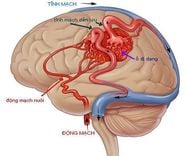This is an automatically translated article.
The article was professionally consulted by Specialist Doctor II Nguyen Binh - Department of General Surgery - Vinmec Ha Long International Hospital.Anesthesia is a method used quite a lot in surgery, making the patient no longer feel pain during the operation.
1. What is anesthesia?
Anesthesia for cholecystectomy, also known as an anesthetic method, is used for the purpose of temporarily losing consciousness, reflexes and sensations with direct-acting anesthetic drugs. to the patient's central nervous system. Anesthesia mainly affects the brain and leads to loss of sensation for the whole body.
Specialists can choose to inject drugs through a vein or give the patient a sniff of suitable anesthetics through the airways. After being anesthetized, the patient will no longer know anything and feel no pain during the bile-intestinal surgery.

Gây mê bằng phương pháp tiêm thuốc qua tĩnh mạch
Anesthesia based on the way into the patient's body will be divided into 3 main types:
1.1 Anesthesia by the patient's inhalation Anesthesia is introduced into the patient's body through the respiratory tract by the patient Inhaling anesthetic vapors and drugs pass through the alveoli to enter the bloodstream, then take effect.
1.2 Anesthesia by other routes Anesthesia by other routes such as rectal, intramuscular, or, intravenous.
1.3 Combined anesthesia Using different anesthetic drugs that enter the patient's body through one or more different routes to induce anesthesia (eg, using propofol to initiate anesthesia through the patient's vein after then maintain anesthesia by giving isoflurane anesthetic through the patient's respiratory tract). Combination of anesthetic and analgesic or muscle relaxant Rapid combination anesthetic with regional anesthetic The main stages of anesthesia prior to ileostomy:
Pain relief: Now the patient remains awake but feels drowsy and responds to analgesia. Arousal: The patient gradually falls into a state of loss of consciousness, appears cortical inhibition leading to the patient falling into a state of agitation, becoming aggressive, salivating, or vomiting. Surgery: The patient lost consciousness, had skeletal muscle relaxation with loss of reflexes, stopped moving eyes, and breathing started to become regular, gradually shallow, and lost the reflex to close the eyelids. Stop using anesthetic, the inhibitory effect of the drug will wear off and the patient's body functions will begin to recover. But if you continue to put more drugs into the patient's body, it can cause medullary paralysis and lead to death.

Sử dụng thuốc mê đúng liều tránh xảy ra biến chứng cho người bệnh
2. Anesthesia in bile-intestinal surgery
Biliary-intestinal anastomosis is often indicated in cases where gallstones have strictures of the muscle of Oddi, or strictures of the biliary tree. In addition, it is also performed when the patient is diagnosed with biliary atresia, pancreatic duodenal tumor, gallstones accompanied by pancreatic sclerosing choledochal cyst, or intraoperative biliary tract injury.
2.1 Indications Relatively indicated for cases of detecting many stones in the liver, having undergone biliary surgery many times because of residual stones or recurrent stones, having a lot of bile sludge, and moderate stenosis of the ampulla of Vater...
2.2 Contraindications Contraindicated in patients in severe condition, with pathologies related to the connecting organs (eg, obstruction, inflammation, stricture, scarring of the intestine), acute pancreatitis, pathology about biliary obstruction due to worms...
Anesthesia during cholecystectomy is the first step, performed by doctors and nurses in emergency resuscitation, surgical anesthesia is also known as initiation. Anesthesia includes:
Sleeping pills: Including intravenous anesthetics (etomidate, propofol, thiopental, ketamine...), and volatile anesthetics (sevoflurane...). Painkillers such as: fentanyl, sufentanil, morphine... Muscle relaxants (only used if necessary): succinylcholine, rocuronium, vecuronium... Conditions for intubation: the patient was in deep sleep, checked for sufficient muscle relaxation.

Đặt ống nội khí quản khi người bệnh hoàn toàn ngủ sâu
2.3 Endotracheal intubation There are two techniques for endotracheal intubation: oral or nasal.
Intubation is combined with ventilation during general anesthesia: Muscles of the body will be paralyzed during the patient's general anesthesia. Therefore, a ventilator is used to provide respiration instead of the lungs. Closely monitor the patient under general anesthesia: By using the necessary electronics to monitor the patient's heart rate, number of breaths, blood oxygen and ECG. Awake from general anesthesia: Depends on the type of surgery they have and how they breathe. The main goal after general anaesthesia is that the patient can be extubated as soon as possible after the end of surgery. 2.4 Safety after the end of general anesthesia in cholecystectomy During the first days after surgery has ended, patients should spend most of their time resting quietly, along with naps combined with the implementation of relaxing activities. Recommendations include: Do not operate heavy machinery, do not drive a car. Note that the patient absolutely must not drink alcohol or use sedatives without following the instructions of the surgeon. Dr. Nguyen Binh has more than 20 years of experience in the field of anesthesia - resuscitation in thoracic surgery, anesthesia resuscitation for elderly patients... Currently a Doctor of General Surgery, International General Hospital Vinmec Ha Long.
Any questions that need to be answered by a specialist doctor as well as customers wishing to be examined and treated at Vinmec International General Hospital, you can contact Vinmec Health System nationwide or register online HERE.








